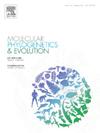布雷迪亚的系统发育、种界和生物地理历史。
IF 3.6
1区 生物学
Q2 BIOCHEMISTRY & MOLECULAR BIOLOGY
引用次数: 0
摘要
由于形态趋同、种间基因流动和历史上有限的采样,植物的物种划分有时具有挑战性。目前定义的布雷迪亚布卢姆包括27个物种,在以前的系统基因组学研究中已被确定为单系。然而,该属的几个主要谱系之间的关系仍然难以捉摸,一些有问题的分类群的种边界尚未得到测试。在这项研究中,我们采用了全面的分类群抽样,并利用单拷贝同源物(SCOs)、基因组单核苷酸多态性(snp)和整个质体重建了Bredia的系统发育。基于SCOs的种树分辨率最高,有力地支持了所有种间关系。我们在感兴趣的群体中确定了形态趋同和潜在杂交/渐渗的实例,并基于单系性、遗传差异和形态可诊断性讨论了物种限制。利用这一强健的系统发育,我们推断出布雷迪亚的分化时间和生物地理历史。该属起源于中新世中期的滇缅泰边境地区和北部湾地区,最初适应喀斯特生境。随着时间的推移,某些谱系转向了非喀斯特环境。一个这样的谱系在中新世晚期迁移到东亚王国的东南部,在那里它迅速多样化形成了几个主要的谱系。随后,一个大陆谱系通过上新世晚期和更新世早期之间的陆桥到达台湾,并在该地区多样化,最终在更新世中期传播到琉球群岛。本文章由计算机程序翻译,如有差异,请以英文原文为准。

Phylogeny, species delimitation, and biogeographical history of Bredia
Species delimitation in plants is sometimes challenging due to morphological convergence, interspecific gene flow, and historically limited sampling. Bredia Blume as currently defined comprises 27 species and has been resolved as monophyletic in previous phylogenomic studies. However, relationships among several major lineages in the genus remain elusive, and the species boundaries of some problematic taxa have not been tested. In this study, we employed comprehensive taxon sampling and reconstructed the phylogeny of Bredia using single-copy orthologs (SCOs), genomic single nucleotide polymorphisms (SNPs), and whole plastomes. The species tree derived from SCOs provided the highest resolution, strongly supporting all interspecific relationships. We identified instances of morphological convergence and potential hybridization/introgression within groups of interest and discussed species limits based on monophyly, genetic divergence, and morphological diagnosability. Using this robust phylogeny, we inferred divergence times and biogeographical history for Bredia. The genus originated in the Yunnan-Myanmar-Thailand Border region and the Beibu Gulf region during the middle Miocene, initially adapting to karst habitats. Over time, certain lineages shifted to non-karst environments. One such lineage migrated to the southeastern part of the Eastern Asiatic Kingdom in the late Miocene, where it rapidly diversified forming several major lineages. Subsequently, a mainland lineage reached Taiwan via a land bridge between the late Pliocene and the early Pleistocene and diversified in the region, eventually spreading to the Ryukyu Islands in the middle Pleistocene.
求助全文
通过发布文献求助,成功后即可免费获取论文全文。
去求助
来源期刊
CiteScore
7.50
自引率
7.30%
发文量
249
审稿时长
7.5 months
期刊介绍:
Molecular Phylogenetics and Evolution is dedicated to bringing Darwin''s dream within grasp - to "have fairly true genealogical trees of each great kingdom of Nature." The journal provides a forum for molecular studies that advance our understanding of phylogeny and evolution, further the development of phylogenetically more accurate taxonomic classifications, and ultimately bring a unified classification for all the ramifying lines of life. Phylogeographic studies will be considered for publication if they offer EXCEPTIONAL theoretical or empirical advances.

 求助内容:
求助内容: 应助结果提醒方式:
应助结果提醒方式:


